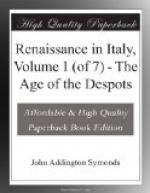Starting with the fact that the eligible burghers
numbered some 5,000, and with the assumption that among
these the larger portion would be content with freedom
and a voice in the administration, while a certain
body were ambitious of honorable distinctions, and
a few aspired to the pomp of titular presidency, they
thought that these several desires might be satisfied
and reconciled in a republic composed of a general
assembly of the citizens, a select Senate, and a Doge.
In these theories the influence of Aristotelian studies[4]
and the example of Venice are apparent. At the
same time it is noticeable that no account whatever
is taken of the remaining 95,000 who contributed their
wealth and industry to the prosperity of the city.[5]
The theory of the State rests upon no abstract principle
like that of the divine right of the Empire, which
determined Dante’s speculation in the Middle
Ages, or that of the divine right of kings, with which
we Englishmen were made familiar in the seventeenth
century, or that again of the rights of men, on which
the democracies of France and America were founded.
The right contemplated by the Italian politicians
is that of the burghers to rule the commonwealth for
their advantage. As a matter of fact, Venice
was the only Italian republic which maintained this
kind of oligarchy with success through centuries of
internal tranquillity. The rest were exposed to
a series of revolutions which ended at last in their
enslavement.
[1] Villari, Life of Savonarola, vol. i. p. 259, may be consulted concerning the further distinction of Benefiziati, Statuali, Aggravezzati, at Florence. See also Varchi, vol. i. pp. 165-70. Consult Appendix ii.
[2] It must be mentioned that a provision for admitting deserving individuals to citizenship formed part of the Florentine Constitution of 1495. The principle was not, however, recognized at large by the republics.
[3] On the Government of Siena (vol. i. p. 351 of his collected works): ’I say not all the inhabitants of the state, but all those who have rank; that is, who have acquired, either in their own persons or through their ancestors, the right of taking magistracy, in short those who are participes imperandi et parendi.’ What has already been said in Chapter II. about the origin of the Italian Republics will explain this definition of burghership.
[4] It would be very interesting to trace in detail the influence of Aristotle’s Politics upon the practical and theoretical statists of the Renaissance. The whole of Giannotti’s works; the discourses of de’ Pazzi, Vettori, Acciaiuoli, and the two Guicciardini on the State of Florence (Arch. St. It. vol. i.); and Machiavelli’s Discorso sul Reggimento di Firenze, addressed to Leo X., illustrate in general the working of Aristotelian ideas. At Florence, in 1495, Savonarola urged his Constitution on the burghers by appeals to Aristotle’s




